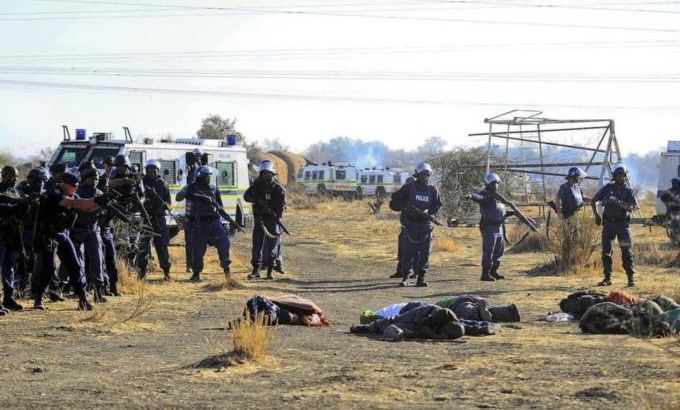
South Africa mine shooting: Who is to blame?
Police who shot and killed 34 striking miners say they fired in self-defence.
The South African police have confirmed that its officers shot and killed 34 striking miners and injured 78 near a platinum mine in North West province.
The officers shot at the workers who were protesting on Thursday afternoon over pay at the Lonmin platinum mine in Marikana, some 100km northwest of Johannesburg.
Keep reading
list of 4 itemsChina’s economy beats expectations, growing 5.3 percent in first quarter
Inside the pressures facing Quebec’s billion-dollar maple syrup industry
Manipur’s BJP CM inflamed conflict: Assam Rifles report on India violence
|
“There has been a protracted process at not only this mine but another neighbouring mine … where this breakaway union … has been using and threatening violence to try to coerce workers into joining their ranks. And this has created an atmosphere of fear and terror, which is destroying the trade union movement in that area.” – Patrick Craven, the national spokesperson for the Congress of South African Trade Unions |
The incident is being described as one of the bloodiest police operations in the country since the end of white-minority rule almost 20 years ago.
But this latest labour dispute is also between unions. The country’s largest syndicate for mine workers is closely allied with the government. It is being challenged by an upstart trade union that is demanding better pay and working conditions.
The union leaders seem to agree on one thing; they accuse the police of committing a massacre. But the police argue that the protesters were armed and the shooting was in self-defence.
Before Thursday, 10 people had already been killed since the start of this illegal strike in violence largely blamed on union rivalry, including two police officers who were hacked to death by striking miners on Monday.
Given the riches beneath their feet at the platinum mine, one union leader said it was only fair they get more pay.
“As long as bosses and senior management are getting fat cheques, that’s good for them,” said Jeffrey Matunjwa of the Mineworkers and Construction Union. “And these workers are subjected to poverty for life. [After] 18 years of democracy, the mineworker is still earning 3,000 [South African Rand – approximately $360] under those harsh conditions underground.”
But what started violently has ended in bloodshed few could have foreseen. It has led labour relations at the mine in tatters and families angry.
So, what was behind this brutal police crackdown and how will it play out politically in South Africa?
Joining Inside Story, with presenter Ghida Fakhry, to discuss this are guests: Patrick Craven, the national spokesperson for the Congress of South African Trade Unions; David Wilson, a senior analyst at IHS Global Insight; and Zweli Mnisi, a spokesperson for the Ministry of Police Services.
| “The situation that we see on the ground now was kind of like a perfect storm in that so much of what was wrong all came together at the same time. So, not only are we in the middle of a recession, not only have we also had very high unemployment for quite a while, not only have we got that sort of strange structural thing … where a worker has to support more than just himself. So, not only have we got all of this. At the same time we have lots of very complex union politics happening all together.”
David Wilson, an analyst at IHS Global Insight |